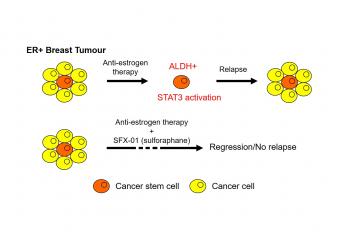Associação Portuguesa de Investigação em Cancro
Targeting STAT3 inhibits endocrine resistant stem cells in ER+ breast cancer
Targeting STAT3 inhibits endocrine resistant stem cells in ER+ breast cancer

Over the last 15 years my research work has been focused in understanding the molecular mechanisms that govern normal and breast cancer stem cells (CSCs). My ultimate goal has always been to translate basic discoveries to clinical applications that can in the long term directly impact on patient care and contribute to a reduction in breast cancer mortality. This work epitomizes this translational research idea because it was pivotal to establishing the grounds for a phase 2 clinical trial on metastatic breast cancer. Most breast cancers are estrogen receptor positive (ER+) and are treated with anti-estrogen therapies to reduce the risk of recurrence. However, resistance to these treatments is a major clinical problem and around one in four patients with ER+ breast cancer see their disease return within 15 years. Thus, new ways to prevent and/or combat drug resistance are urgently needed. My previous work established that anti-estrogen treatments do not target breast CSCs, which is of paramount importance for ER+ breast cancer management and sparked my interest in developing strategies to target these CSCs in patients. This work now describes novel biology that underpins anti-estrogen resistant breast CSCs by showing that ALDH-positive CSCs have increased dependence on STAT3 signaling. Importantly, we found that combining anti-estrogen therapies (tamoxifen or fulvestrant) with a novel drug (SFX-01) can target breast CSCs by inhibiting STAT3 signaling. SFX-01 is based on a natural plant-derived compound (sulforaphane) found in cruciferous vegetables, like broccoli and rocket, and it reduces CSCs ability to form 3D colonies in vitro and tumours and metastases in vivo in mice. Gene expression analysis of anti-estrogen resistant CSCs from patient samples confirmed increased expression of STAT3-regulated genes. Interestingly, expression of two of the most up-regulated genes (OSMR and MUC1), previously associated with breast CSC activity, was significantly reduced when endocrine-resistant patient samples were treated with SFX-01. It goes without saying that all this work would not have been possible without an extraordinary team effort involving research groups from the UK, France and Italy. SFX-01 was trialled in the clinic in patients whose breast cancers had already developed resistance to endocrine therapy showing delayed disease progression in a quarter of patients (STEM trial, NCT02970682). Thus, SFX-01 can help overcome anti-estrogen resistance by blocking the activated STAT3 signalling pathway and provides a potential strategy to cure some therapy-resistant tumours. Further research will be needed to understand why some patients responded to SFX-01 in order to optimise the precise patient group who are likely to benefit from this drug. In the future, a diagnostic test for STAT3 signalling activity could potentially be used as a biomarker to identify the patients who are most likely to respond to SFX-01 treatment. It is also hoped that SFX-01 could in future be added to endocrine therapies from the outset of treatment to prevent resistance from developing in patients with ER+ breast cancer.
Bruno M. Simões1, Angélica Santiago-Gómez1, Chiara Chiodo1,2, Tiago Moreira1, Daniel Conole3, Scott Lovell3, Denis Alferez1, Rachel Eyre1, Katherine Spence1, Aida Sarmiento-Castro1, Bertram Kohler1, Ludivine Morisset4, Marilena Lanzino2, Sebastiano Andò2, Elisabetta Marangoni4, Andrew H. Sims5, Edward W. Tate3, Sacha J. Howell1,6, Robert B. Clarke1
1 Breast Biology Group, Manchester Breast Centre, Division of Cancer Sciences, Faculty of Biology, Medicine and Health, University of Manchester, Manchester, UK
2 Department of Pharmacy, University of Calabria, Arcavacata di Rende, Italy
3 Molecular Sciences Research Hub, Imperial College London, UK
4 Institut Curie, PSL Research University, Translational Research Department, Paris, France
5 Applied Bioinformatics of Cancer Group, University of Edinburgh Cancer Research UK Centre, Edinburgh, UK
6 Dept. of Medical Oncology, The Christie NHS Foundation Trust, Manchester, UK
Estrogen receptor (ER) positive breast cancer is frequently sensitive to endocrine therapy. Multiple mechanisms of endocrine therapy resistance have been identified, including cancer stem-like cell (CSC) activity. Here we investigate SFX-01, a stabilised formulation of sulforaphane (SFN), for its effects on breast CSC activity in ER+ preclinical models. SFX‐01 reduced mammosphere formation efficiency (MFE) of ER+ primary and metastatic patient samples. Both tamoxifen and fulvestrant increased MFE and aldehyde dehydrogenase (ALDH) activity of patient-derived xenograft (PDX) tumors, which was reversed by combination with SFX‐01. SFX-01 significantly reduced tumor initiating cell frequency in secondary transplants and reduced the formation of spontaneous lung micrometastases by PDX tumors in mice. Mechanistically, we establish that both tamoxifen and fulvestrant induce STAT3 phosphorylation. SFX-01 suppressed phospho‐STAT3 and SFN directly bound STAT3 in patient and PDX samples. Analysis of ALDH+ cells from endocrine-resistant patient samples revealed activation of STAT3 target genes MUC1 and OSMR, which were inhibited by SFX-01 in patient samples. Increased expression of these genes after 3 months’ endocrine treatment of ER+ patients (n=68) predicted poor prognosis. Our data establish the importance of STAT3 signaling in CSC-mediated resistance to endocrine therapy and the potential of SFX-01 for improving clinical outcomes in ER+ breast cancer.
Oncogene
https://www.nature.com/articles/s41388-020-1335-z




